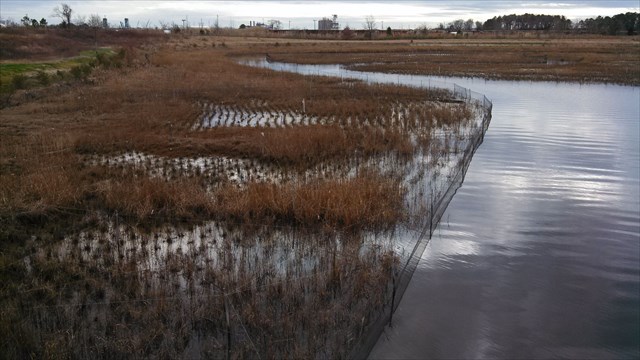What does it take to restore an urban river?
Take a walk in Paradise Creek Nature Park and find out.

This Earth Cache will share some of the history of the Elizabeth River and the impact of civilization on the river. You will learn about some of the efforts being taken to restore the river’s health.
To claim this Earth Cache you will need to visit the signs along the trails (http://www.paradisecreeknaturepark.com/#!park-map/coyt) and answer the questions below.
Email the answers to steve-n-kim through Geocaching.com.
Please do not put the answers in your log or post pictures of the signs.
Paradise Creek Nature Park (http://www.paradisecreeknaturepark.com) provides the rare opportunity to enjoy a restored Elizabeth River - first-hand. This 40-acre, waterfront park will teach generations what it takes to bring back the health of an urban river, once presumed dead. Two miles of trails lead the visitor through an urban forest under revitalization, 11 acres of new tidal wetlands, and past industrial partners all doing their part to bring back your home river.
Captain John Smith was sent to explore the Chesapeake Bay in search for one special thing, an ideal harbor for trade with the New World. He found it on the Elizabeth River, which is still known today as the largest natural harbor in the world. The river is the cradle of maritime history, the very spot where such innovations as dry docks, iron clad ships and air craft carriers were invented.
Since this river's discovery, the challenge and opportunity for the Elizabeth has been to remain a living river, a healthy spot for crabs and fish to thrive alongside shipping traffic, while growing into a great port. Unfortunately, over the centuries the river has become the most polluted river on the Chesapeake Bay. While her surface sparkles like diamonds, quite a bit of goo has settled down to her bottom.
Sign 1: Why should only rain go down the drain?
When Captain Smith and his crew arrived 400 years ago the captain noted in his journal, "Shores overgrown with the greatest pine and fir trees we ever saw in the country." Captain John Smith noted oysters the size of dinner plates, big enough to feed an entire family, were in the Elizabeth River portion of the bay! He recorded fish so plentiful his crew could catch them by leaning over the side of the boat and hitting them on the head with a frying pan.
Sign 2: Urban children do better with nature. What percentage of at-risk urban youth report that they have never spent time in a natural setting?
The wonderful natural harbor here attracted the founding in 1767 of the oldest and largest naval shipyard in your country, today known as Norfolk Naval Shipyard. If you had lived then, you would have seen the river's great forests disappear into tar pots, timber sheds and a sawpit, with the smell of oak gum filling the air to make the great sailing warships of the day.
Sign 3: What kind of clean up is win-win? How many acres of restored habitat did the Navy create along Paradise Creek?
To accommodate modern lives in the 1880s, the Elizabeth River started to be filled to two-thirds her normal width and dredged to twice her normal depth. This destroyed much of the wetlands and shallows that supported the river's abundant crabs and fish. The Elizabeth River lost 50 percent of her tidal wetlands and her shores were converted to concrete as much as six miles at a stretch.
Sign 4: Why bring back wetlands? How much fill was dug up to create the 11 acres of wetlands in the park?

Sign 5: How do trees help the river? How many trees did River Star Enviva plant in the park?
In the early 1900s, the harvest of oysters was banned due to contamination from sewage and is still banned today. Down the Southern Branch, there is a site known as Money Point where wood treatment facilities coated the great timbers with tar, made into "creosote" and allowed it to drip and wash into the river bottom. Scientists say the creosote pooled on the bottom of the Elizabeth's Southern Branch and represents some of the highest concentrations in the world—associated with cancer in our fish and risks to human health.
Sign 6: How does it help the river to clean up the air? How does the Jordan River Bridge help restore the river?
Sign 7: Why “clean Elizabeth’s bottom”? How much “goo” was removed from the river bottom at Money Point?
In 1991, four citizens founded the Elizabeth River Project based on the belief that citizens, government and industry can work together, hand in hand, to achieve the balance of a healthy river and a healthy economy. Out of such an unusual idea was born a most potent partnership. Today we see the powerful results on every shore, brought about by dozens of industries, government partners and ordinary citizens, rallying for our river's restoration. These industrial stewards are called "River Stars." Today we have 60 River Star industries participating, including almost every one of the largest industrial interests on the river. This year alone, they documented reducing pollution by 3.4 million pounds! Not only are today's port facilities reducing pollution, they're bringing back the green shore.
Sign 8: What are seven easy steps home owners can take to help restore the river?
For more information on the Elizabeth River history and restoration projects visit http://www.elizabethriver.org
-:¦:- Congratulations Episcodad on your FTF -:¦:-